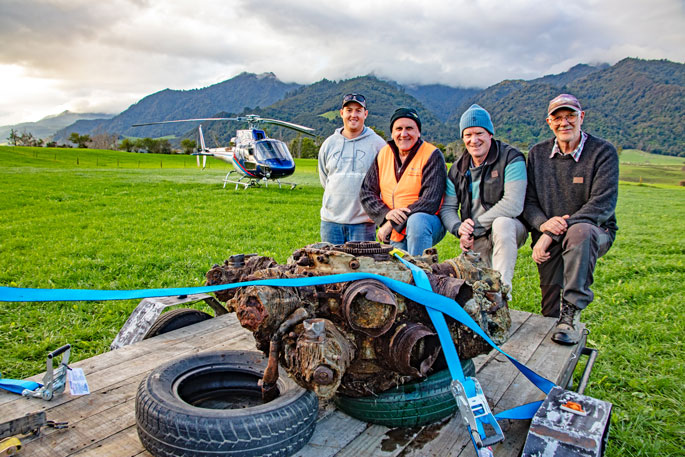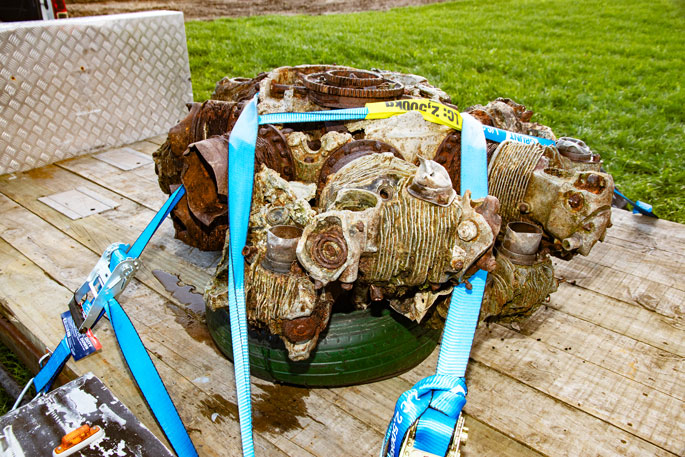He was a nine-year-old at his school desk. Class had just started, 9am Wednesday, July 3, 1963. Dave Hooper remembers it well.
'Our school was only a kilometre from the foothills of the Kaimais. But you couldn't see them that day. That's how closed in the weather was.”
There was the noise. The sound of an aircraft, muffled by the wind and rain. Suddenly the engine roared, then a bang…..and nothing. 'We just looked at one another,” recalls Dave. The quarry across the road would sometimes blast rock, but never on a bad day. And this was a bad day. Something was very wrong.
Moments later a Tauranga air traffic controller muttered despairingly: 'I've lost an aircraft”.
Dave's class wasn't to know New Zealand's worst domestic air disaster was going on around them. NAC Flight 441 had slammed into a vertical rock face, all 23 people aboard dead.
Soon there'd be army vehicles up and down Old Te Aroha Rd at Gordon near Matamata. And Dave and his classmates would be told they were looking for a lost aeroplane.
'We were sent home early because they needed the school for search and rescue.”
Then on Wednesday just gone – June 28, 2023 – and almost 60 years to the day after the crash, the unpredictable and unforgiving Kaimai Range was having a rare vulnerable moment.
A chopper on a salvage mission slipped in beneath a low canopy of cloud and fog and wrested the NAC Flight 441's starboard engine from the range's grasp.
It didn't surrender it easily. 'Wind is swirling like a bastard,” radioed in the pilot.
It was Classic Flyers Museum's second attempt to retrieve the engine. 'A feeling of trepidation,” says CEO Andrew Gormlie. 'You got it, nervous.”
 Sixty years after the crash, Flight 441's engine is finally headed home. From left: Adventure Helicopters pilot Will Dolman, Classic Flyers CEO Andrew Gormlie, Adventure Helicopters pilot Shamus Howar, and Grant Horn, the man behind the plan to recover the engine.
Sixty years after the crash, Flight 441's engine is finally headed home. From left: Adventure Helicopters pilot Will Dolman, Classic Flyers CEO Andrew Gormlie, Adventure Helicopters pilot Shamus Howar, and Grant Horn, the man behind the plan to recover the engine.
Then the chopper appears on the skyline above a ravine with the engine, the prize, slung beneath on a long line. 'We've got it,” calls the pilot. And 4km way in a paddock by the Old Te Aroha Rd, Gormlie and a whole raft of aviation enthusiasts and locals are anxiously waiting and watching.
'I can see it, bloody exciting,” says Andrew. 'Outstanding. The engine is heading home.” Home to Classic Flyers at Tauranga Airport, the aircraft's original destination.
To most, the engine would appear a piece of tortured, broken and burnt metal. But for the salvage team, it's a gem, an artefact, a piece of aviation history. 'It's still recognisable and sufficiently intact for people to understand what it is.”
And there's a reverence amongst the salvage team – because that piece of wreckage on the trailer is now a museum icon. People are standing around looking, admiring and reflecting on a disaster 60 years ago.
Grant Horn, the man who conceived the salvage, is a happy man. 'I decided it was going home to Tauranga or it was going nowhere. It would be staying right here.”
'We believe that with the engine, Classic Flyers can tell the story of the crash very respectfully,” says Andrew. And they don't believe they have violated the sanctity of the crash site because the engine and wheel had rolled well clear.
'It's a wreck, not a tomb. And it's important for us to respectfully recover the engine so there is some tangible reminder for people. And the engine fulfils the museum objective – to promote and preserve aviation history.”
Andrew says they tested the feeling of people. 'Those affected by the tragedy were certainly comfortable with it.”
The starboard engine sheered off when ZK-AYZ hit a craggy, verticle cliff, and along with the starboard wheel assembly, eventually tumbled into a ravine. The engine and the wheel assembly, will be housed in a ‘remembrance room' at the museum, part of a permanent commemorative display. It'll be dedicated at a special 60th anniversary service at the museum at 1.30pm next Monday afternoon on July 3. The public is invited.
Among those attending the service is likely to be 86-year-old Mrs Sandy Saussey. She was the wife of Captain Len Enchmarch, who was killed in the crash.
'It'll likely be the final time for relatives of those lost, and others with direct involvement by way of search and recovery efforts, to gather together to pay their respects,” says the Rev Dr Richard Waugh, a noted aviation historian and writer on the disaster.
 Hammered by the impact of the crash, but still recognisable as Flight 441's engine. Photo: Bob Tulloch.
Hammered by the impact of the crash, but still recognisable as Flight 441's engine. Photo: Bob Tulloch.
Classic Flyers archivist Peter Layne had a very personal attachment to the DC-3. 'CZK-AYZ was the first plane I flew in without my parents – Whenuapai to Hamilton just two years before the accident.” And through his NAC operations officer Dad, the then sevenor-eight-year-old Peter Layne met and chatted with First Officer Peter Kissel, who was killed in the crash.
Shortly after 9am this coming Monday morning, people will pause and reflect on the final moments of Flight 441 as another DC-3 – the ZK-DAK out of Ardmore – thunders over a commemoration service, this time a roadside service, at the Kaimai crash memorial plaque on the Old Te Aroha Rd at Gordon. The half-hour service will conducted by Rev Waugh and the Roman Catholic Bishop of Auckland, Steve Lowe, himself an aviation historian.
Back in 1963, Dave Hooper and his uncle tramped into the crash site, as many people did. The uncle took a couple of raw, confronting photographs, which Dave has shared with The Weekend Sun. They graphically show the devastation.
It left an enduring impression on a young boy. 'It was the smell, a distinctive smell– fuel, burning...yes, and death.”
They'd say if you stood at the crash memorial on Old Te Aroha Rd and gazed 4km up into the ravine on the Kaimai Range, then on the right day and in the right weather, you might see the wreckage shimmering in the sun. But no more – the army detonated a whole rock face with the aim of burying the crash site and deterring souvenir hunters.



0 comments
Leave a Comment
You must be logged in to make a comment.